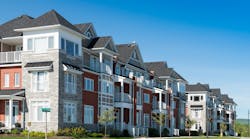Latest from Construction Data
Sponsored
LAS VEGAS, NV – Multifamily starts are predicted to fall in 2023, following an unsustainable high level of production last year, according to the National Association of Home Builders (NAHB). Meanwhile, the remodeling sector remains on solid ground and will do better than the single-family and multifamily markets in 2023.
Multifamily construction boomed in 2022, up an estimated 15% from the previous year and exceeded a 500,000 annual pace—the first time since the Great Recession. However, NAHB is projecting that multifamily starts will fall 28% this year to a 391,000 total and will stabilize in 2024 at about 374,000 starts.
Large Backlog
“Slowing rent growth, rising unemployment, tightening commercial real estate financing conditions and a substantial amount of supply in the construction pipeline have caused a large backlog of multifamily developments,” said NAHB Assistant Vice President for Forecasting and Analysis Danushka Nanayakkara-Skillington at a press conference held during the NAHB International Builders’ Show in Las Vegas.
There are currently 943,000 apartments under construction, up 24.9% compared to a year ago (755,000). This is the highest count of apartments under construction since 1974. Looking at another metric, eight of the top 10 multifamily markets, as measured by the number of permits, posted yearly increases from November 2021 to November 2022.
The New York-Newark-Jersey City region, the largest in the nation, registered a 9% increase in permits, while Atlanta-Sandy Springs-Roswell, Ga., had the highest increase at 203%. The following markets all posted gains as well: Dallas-Fort Worth-Arlington, Texas; Houston-The Woodlands-Sugarland, Texas; Los Angeles-Long Beach-Anaheim, Calif; Washington-Arlington-Alexandria, D.C.-Va.-Md.-W.Va.; Phoenix-Mesa-Scottsdale, Ariz.; and Minneapolis-St. Paul-Bloomington, Minn.-Wisc. The markets in Austin-Round Rock, Texas, and Seattle-Tacoma-Bellevue, Wash., posted declines compared to the previous year.
Nanayakkara-Skillington noted that regulations greatly affect multifamily development costs, referencing research conducted by NAHB and the National Multifamily Housing Council. “Apartment and condo developments can be subject to a significant array of government regulations including zoning requirements, building codes, impact fees, permitting requirements, design standards and public land requirements, among others,” said Nanayakkara-Skillington. “These regulations are exacerbating the nation’s housing affordability crisis.”
Remodeling Market
Meanwhile, residential remodeling activity is estimated to increase 7% on a nominal basis in 2022 following a growth rate of 13% in 2021 as people continue to use their home for more purposes such as offices, schools and gyms. However, with housing demand weakening, remodeling growth is expected to slow, posting a nominal 5% gain this year and a 4% increase in 2024.
“Remodeling activity should start to pick up by the end of 2023 as interest rates on home improvement loans begin to trend downward,” said Nanayakkara-Skillington.Nanayakkara-Skillington also noted that the NAHB/Westlake Royal Remodeling Market Index was down year-over-year for the fourth quarter of 2022 but remained in positive territory with a reading of 66, well above the break-even point of 50.
Labor Shortages
Supply-side challenges have impacted all sectors of the housing market over the past several years, including a lack of skilled labor. There were 388,000 open construction positions in November 2022 compared to 352,000 a year ago. Builders are reporting shortages of labor in the following fields: framing crews, carpenters, bricklayers/masons, concrete workers, among others.Building material and product shortages have also been an issue for the industry.
NAHB data show that the products most difficult to get are appliances, transformers, windows, doors and HVAC equipment.In May of 2021, NAHB reported on historically widespread building material shortages, but since then, most of the shortages have eased—the major exceptions being shortages of HVAC equipment and certain categories of ceramic materials (ceramic tiles, clay bricks and cement-based building materials), which have gotten slightly worse.The cost of building materials has been another supply-side challenge for the industry, noted Nanayakkara-Skillington. “While the rate of increase in building materials is down year-over-year, costs still remain elevated,” she said.


